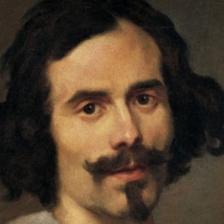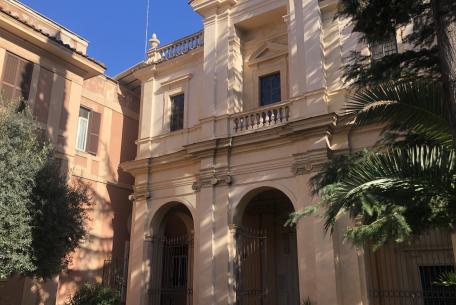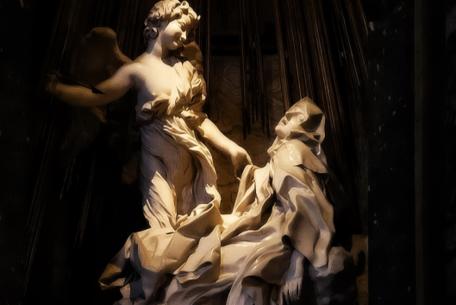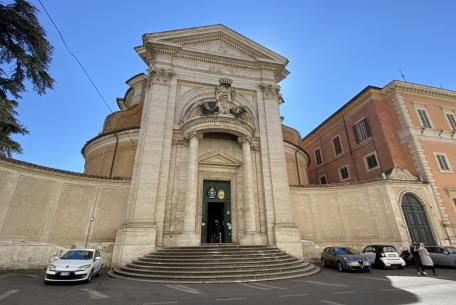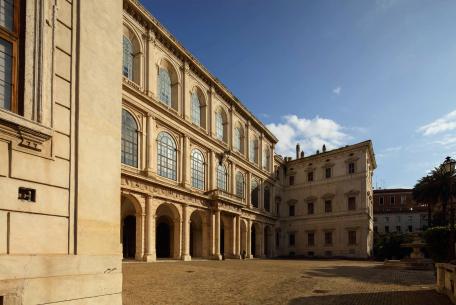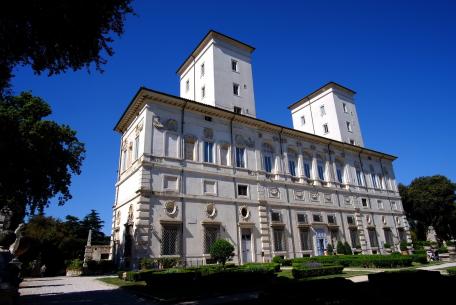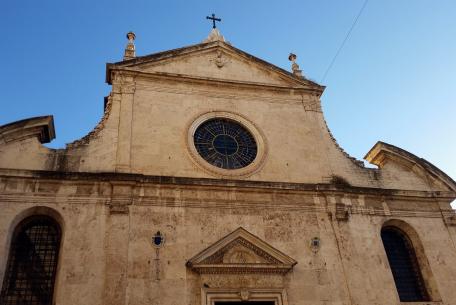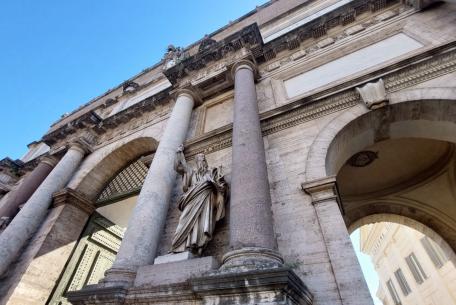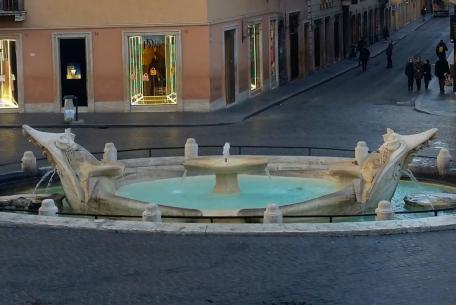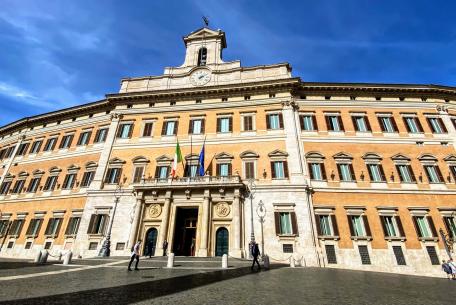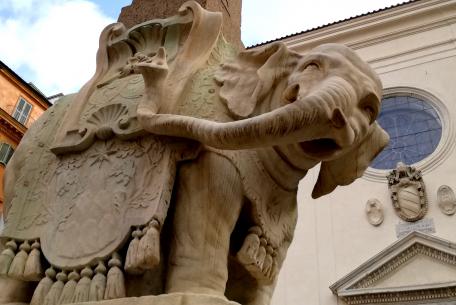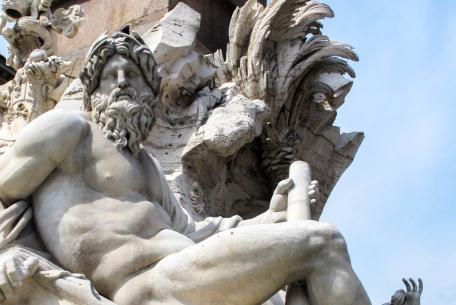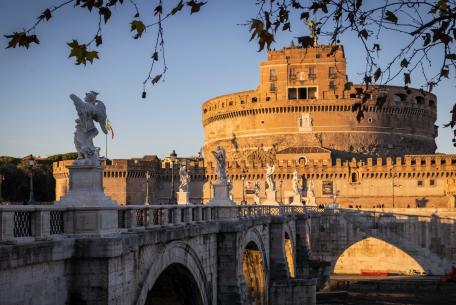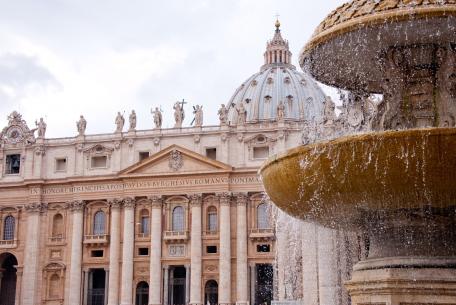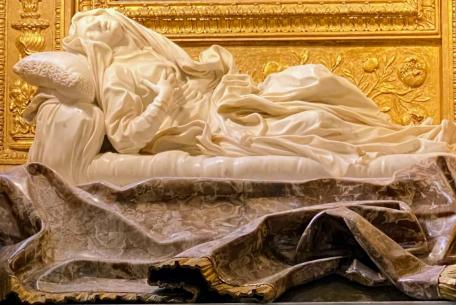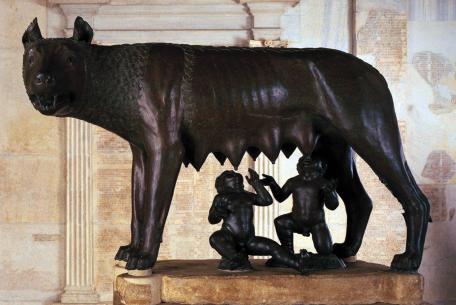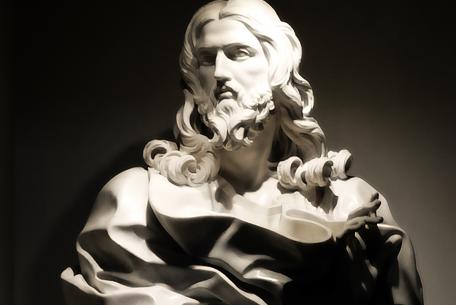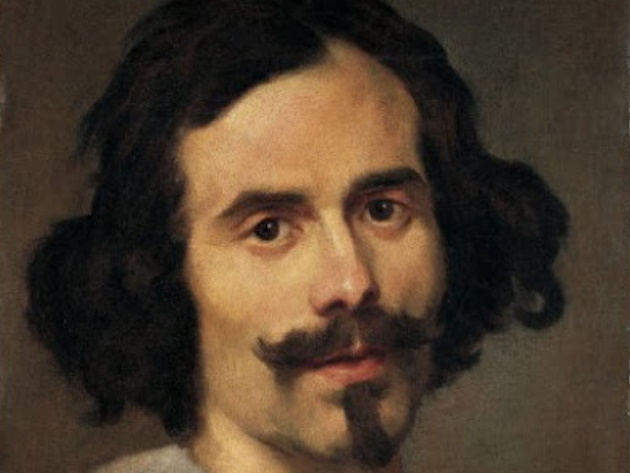
Gian Lorenzo Bernini was born in Naples on 7th December 1598. When he was still a child, he moved to Rome to stay with his father Pietro, a sculptor working at Cappella Paolina of Santa Maria Maggiore. He hadn’t turn 20, when he received his first commissions that would bind him to Rome for the rest of his life. He soon revealed to be a precocious talent, as the four marble groups testify: Aeneas and Anchises, the Rape of Proserpina, David and Apollo and Daphne, realized for cardinal Scipione Borghese between 1619 and 1625. Today, they can still be admired in Borghese Gallery. Bernini’s talent, charm and relationship skills allowed him to obtain the most important public and private commissions. He tirelessly worked for five popes. The “enfant prodige” of Baroque art excelled in all artistic disciplines: design, scenography, sculpture, architecture, painting and city planning. He became one of the greatest, if not the greatest protagonist of the papal city’s urban transformation. His luck especially derived, from pope Urban VIII Barberini protecting him and favouring the official recognition of his talent. Bernini’s biography by Filippo Baldinucci tells about Urban VIII aiming at creating “a second Michelangelo”. He engaged Bernini to build masterpieces such as Saint Peter’s Baldacchino (1633), the Fountain of Triton (1642-43), the Fountain of the Bees (1644) and the pope’s monumental tomb in Saint Peter’s Basilica (1643-47).
The Fountain of the Four Rivers in Piazza Navona (1648-51), built for pope Innocent X Pamphilj, is a famous and gorgeous example of Bernini’s technical and creative skills. Under pope Alexander VII Chigi he worked at his city plans such as the Colonnade in Saint Peter’s square (1659) and the almost unknown, ephemeral and scenographic project in Piazza di Spagna for the birth of the Grand Dauphin of France. The Pontificia Collegiata in Castel Gandolfo (1658-61) and the Chiesa dell’Assunta in Ariccia (1661-64) both belong to the same period.
Bernini lived and worked in Rome all his life long, except when he was invited to Paris by king Louis XIV in 1665 to realize the royal equestrian statue, a sketch of which is kept in Borghese Gallery, and to restore Louvre. Versatile brilliant man and Baroque artist, Bernini died in Rome on 28th November 1680.
He is now buried in a modest tomb in the Basilica of Santa Maria Maggiore.
Download here the full itinerary
Chiesa di Santa Bibiana
Via Giovanni Giolitti, 154
On the occasion of the jubilee in 1625 and just after Santa Bibiana’s remains were miraculously found, Bernini was called to restore the facade of Santa Bibiana’s church. It is considered his first architecture work as well as Santa Bibiana’s statue (1624-26), representing the Saint with the palm and the column, symbols of her martyrdom, also housed in the church, is acknowledged as Bernini’s first sculpture.
Chiesa di Santa Maria della Vittoria - L’Estasi di Santa Teresa d’Avila
Via XX Settembre, 17
The church of Santa Maria della Vittoria hosts various sculptures and paintings by great artists such as the altarpieces by Domenichino and Guercino. Here is also the chapel built for cardinal Federico Cornaro where the excellent masterpiece by Bernini Ecstasy of Saint Teresa d’Avila stands out surrounded by the chapel itself. The sculptor skilfully gives life to Saint Teresa’s celestial ecstasy playing with light as in a theatre scenography, after the description of Saint Teresa herself: “un idillio così soave quello che si svolge tra l’anima e Dio”. (ndt. “Such a sweet idyll that takes place between the soul and God”).
Chiesa di Sant’Andrea al Quirinale
Via del Quirinale, 30
Bernini succeeds in showing off his skills as a church planner only in the 60s of the XVII century. The most important project is the church of Sant’Andrea al Quirinale (1658-70). Here the architect decides to design an elliptical base surmounted by a coffered dome. This particular choise allows Bernini to present the space as the place where the miracle occurs: Saint Andrew’s ascension takes shape in the concave pediment of the altar after his martyrdom, portrayed in the altarpiece. Adjacent to the church is the wonderful sacristy also designed by Bernini and frescoed by Jean La Brode.
Galleria Nazionale d’Arte Antica - Palazzo Barberini
Via delle Quattro Fontane, 13
It was built in 1625. It was conceived as a real villa in the city centre to host the pope’s family. It is the result of the cooperation between three master architects: Maderno, Bernini and Borromini. When Maderno died, Bernini took his place and ended the works. He built a part of the interior too, among them the loggia and the underlying portico as well as the large square well staircase which is specular to Borromini’s helicoidal one. Today, seat of the National Gallery of Antique Art, the building hosts some of Bernini’s sculptures, like the busts of Antonio Barberini, Urban VIII, and Clement X, and two paintings: the portrait of Urban VIII and David with the head of Goliath.
Fontana del Tritone
Piazza Barberini
The Triton Fountain was commissioned by pope Urban VIII and built in the middle of Barberini Square between 1642 and 1643. This fairy tale looking fountain, with its water coming from the Felice Aqueduct, wishes to represent the sea world. Four dolphins within a big basin sustain a shell upon which stays Triton playing a murex shell. Never missing the bees, heraldic symbol of the Barberinis.
Fontana delle Api
At the corner of Via Veneto and Via di San Basilio Not far from the Triton Fountain is the Fountain of Bees. It was also commissioned by pope Urban VIII Barberini, as it is engraved on the shell. In fact, the fountain was conceived as an open shell from the valves of which water is poured under the protection of the Barberinis’ bees.
Masterpieces at Galleria Borghese
Piazzale Scipione Borghese, 5
Reservation required Anyone wanting to appreciate Bernini as a sculptor cannot miss Galleria Borghese Museum. Here, his most famous works are housed. Capra Amaltea (1615) is one of Bernini first sculptures, followed by Aeneas, Anchises and Ascanius (1618-19), the Rape of Proserpina (1622), Apollo and Daphne (1622-25) and David (1623). They all represent the best of Bernini’s virtuous skills to express the pathos of human soul by twisting the bodies and giving an intense expressiveness to the faces. Galleria Borghese Museum hosts more examples of Bernini’s versatile nature like the self-portrait paintings, the realistic busts of Scipione Borghese and the terracotta sketch of the equestrian statue commissioned by Louis XIV but never made.
Basilica di Santa Maria del Popolo
Piazza del Popolo, 12
Santa Maria del Popolo church (XI-XVI Century) gathers a mixture of styles in its structure. Here we can admire works by Raffaello, Bramante, Maderno and Bernini just to name some. Bernini decorated the naves and the transept with stucco in Baroque style, he realized the sculpture Abacuc and the angel in the Chigi Chapel and decorated the monumental organ adorned by the Chigis’ heraldic oak.
Porta del Popolo
Porta del Popolo is far different from the original monument built during Aureliano’s Empire. In fact, Bernini was called to decorate the internal facade for the visit of Queen Christina of Sweden to Rome, following her conversion to Christianity, as it is also engraved on the epigraph placed under the Chigis’ crest.
Fontana della Barcaccia
Piazza di Spagna
This famous fountain is the result of the cooperation between Pietro Bernini and his son Gian Lorenzo. The Romans fondly call it “Barcaccia” because of its peculiar shape which recalls a half-sunken boat. Probably inspired by the Tiber flooding, this masterpiece lies at the foot of the Spanish Steps and it is placed on a lower level than the street level in order to better exploit the water low pressure.
Palazzo Montecitorio
Piazza di Montecitorio
Now the seat of the Chamber of Deputies, Palazzo Montecitorio (1653) was commissioned by pope Innocent X Pamphilj as wedding present for his nephew Camillo Ludovisi. Bernini designed a building with a convex polygonal front in order to adapt it to the irregular soil. The building was later completed by the architect Carlo Fontana, nonetheless some Baroque parts made by Bernini are still visible like the rocky spurs with leaves and twigs coming out from under the shelves of the windows to simulate a building sculpted in the rock.
Obelisco della Minerva
Piazza della Minerva
This obelisk is known as Pulcino della Minerva, (ndt the chick of Minerva) and it is the smallest of the nine Egyptian obelisks in Rome. Bernini gave it a Baroque style by placing it on top of a small elephant inspired by the elephant that Queen Christina of Sweden had offered as a present to Rome. The small elephant symbolizes the strength of mind, which is necessary to support a solid knowledge, as it is engraved on the basement.
Fontana dei Quattro Fiumi
Piazza Navona
The majestic Fountain of the Four Rivers (1641- 48) is considered one of the greatest masterpieces of the artist. A magnificent combination of architecture and sculpture. Located in the centre of Piazza Navona, opposite the church of Sant’Agnese in Agone, the fountain appears as a cliff supporting the obelisk. All around the cliff are four colossal white marble statues representing the most important rivers of the continents known until then: the Danube for Europe, the Ganges for Asia, the Rio de la Plata for the Americas and the Nile for Africa. Groups of animals and plants are placed next to each figure to identify the different continents in addition to the large crest of the Pamphilijs that celebrates the commissioner: pope Innocent X.
Ponte Sant’Angelo
Lungotevere Vaticano
Saint Angel bridge less famous second name is Pons Hadriani, from the name of the emperor Hadrian that commissioned it. It is adorned by splendid statues of angels made by Bernini together with his students, who were believed to be among the best sculptors of the Baroque Rome. The ten angels, divided into two groups, towered on high pedestals engraved with Ancient Scriptures, hold the symbols of Christ’s Passion in their hands. The angel with the crown of thorns and the one with the inscription INRI were made by Bernini. At one point, they were replaced by copies made by his students being the originals so import and fragile that they were later moved to the church of S. Andrea delle Fratte, a few steps from the Spanish Steps.
Colonnato e Basilica di San Pietro
Piazza San Pietro
Saint Peter’s Basilica is a real treasure chest containing paintings and sculptures of inestimable value. The church structure testifies the genius of great artists such as Carlo Maderno, Michelangelo and Bernini. The external Colonnade made by Bernini (1659), consists of 284 columns organized in four rows. Absolutely not to be missed is the perspective game. The observer positioned on one of the two focuses of the elliptical-shaped square, will see the four rows of columns overlapping and will have the impression that the colonnade is made up of one single row. Just to remember Bernini’s works inside the church we shall name: the monumental Baldacchino (1634) placed to indicate Saint Peter’s tomb, the funeral monument of Urban VIII (1628) and the one of Alexander VII (1671-78), the Monument to Matilde di Canossa. The precious Tabernacle of the Sacrament, in gilded bronze and lapis lazuli, and the Scala Regia (1663-66), a staircase, with a bright forced perspective, going from the Apostolic Palace to the square, are also designed by Bernini.
Chiesa di San Francesco a Ripa - Monumento a Beata Ludovica Albertoni
Piazza di San Francesco d’Assisi, 88
On the occasion of the beatification ceremony of the nun Ludovica Albertoni, member of the Third Order of Saint Francis, Bernini was called to restore the Altieri Chapel, inside the church of San Francesco a Ripa. Here he realized the marble sculpture, Ecstasy of Blessed Ludovica Albertoni (1674). The Blessed is shown lying on a marble bed, her head bending back and her mouth half-open, while, wrapped in a soft dress with deep folds, she presses her hands on her chest. The moment of the death of the Blessed is here changed into a moment of ecstasy, as a conjugation with the Divine. The skilful combination of architecture, sculpture, light and colours is the perfect expression of Baroque aesthetics.
Musei Capitolini - Busto di Medusa
Piazza del Campidoglio, 1
The huge Collection of Capitoline Museums, the oldest public collection in the world, also includes Medusa’s fine marble bust (1644- 48) which is considered one of Bernini’s most peculiar works. Bernini was able to capture and immobilize an action in full development and to clearly depict it. This sculpture represents the classic myth of Medusa in the moment of her metamorphosis when the Gorgon sees her image reflected in a mirror and turns into marble.
Basilica di San Sebastiano fuori le mura - Salvator Mundi
Via Appia Antica, 136
There is a peculiar story about the bust representing Salvator Mundi (1679). It is Bernini’s last work who, now in his eighties, left it as a present for Queen Christina of Sweden. Art historians discovered this masterpiece coming from Albani sacristy, only in 2001 as they recognized Bernini’s style by the rich drapery, the thick hair with voluminous curls on the shoulders and the act of blessing blocked over time. Called by Bernini himself “his Pride and Joy”, this work tells us about an aged artist spending his last days practicing religion.
 Condividi
Condividi












































